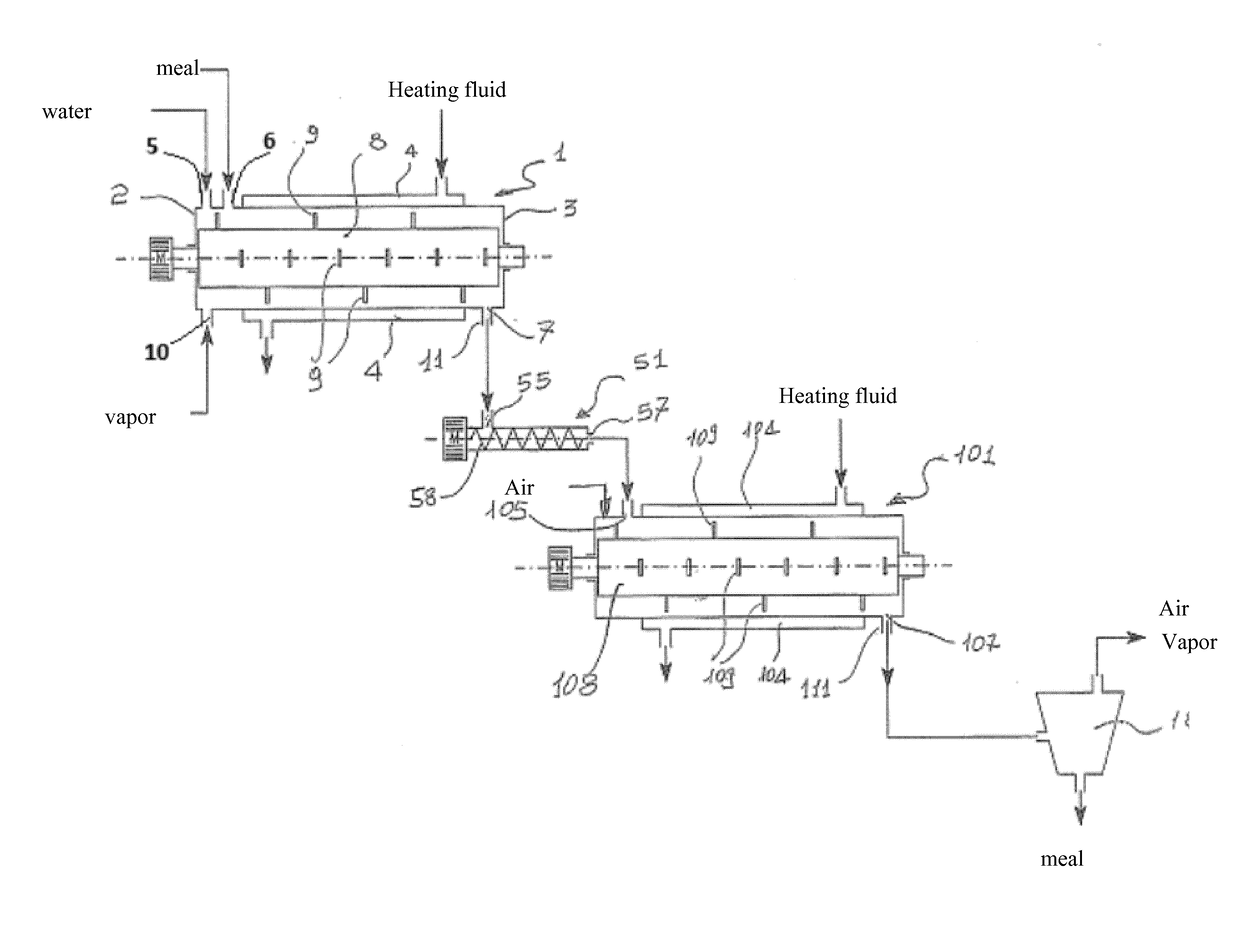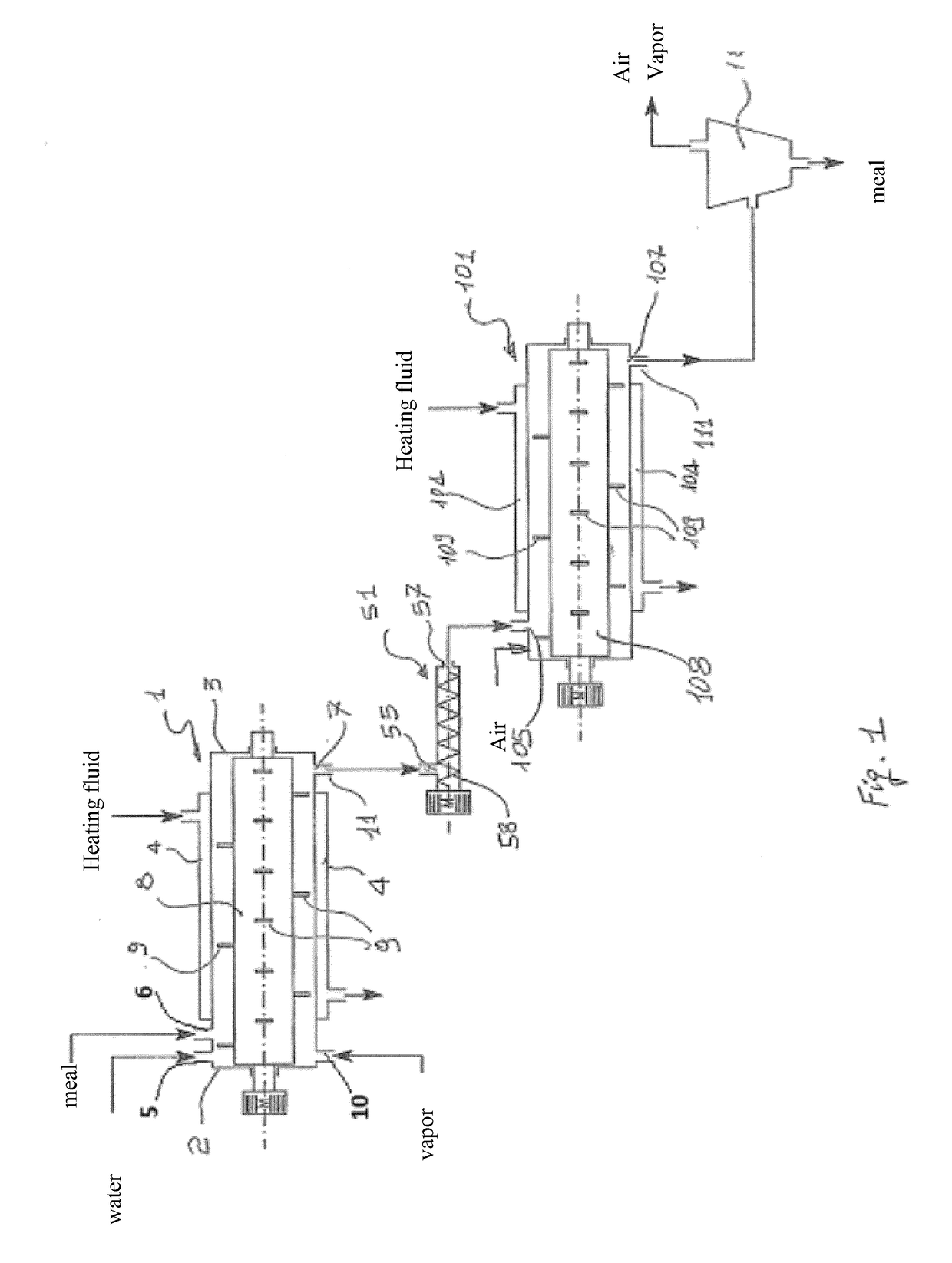Process for improving the organoleptic and nutritional properties of legume meal and components and derivatives thereof
a technology of legume meal and organoleptic properties, which is applied in the field of legume meal production with improved organoleptic and nutritional properties, can solve the problems of immunitary diseases, hindering the digestive process in the intestine, increasing intestinal permeability, etc., and achieves the effects of promoting maillard reaction, improving taste of meal, and improving organoleptic properties
- Summary
- Abstract
- Description
- Claims
- Application Information
AI Technical Summary
Benefits of technology
Problems solved by technology
Method used
Image
Examples
example 1
[0058]A flow of yellow pea meal (80 kg / h) with a moisture content of 14.4% was continuously fed, through the opening 6, into the wet heat treatment reactor 1, inside which the bladed rotor 8 was rotated at a speed of 700 rpm. At the same time a flow of water at 80° C. (20 kg / h) was continuously fed through the opening 5, and a flow of steam was continuously fed through the opening 10 at 105° C. (15 kg / h).
[0059]Immediately at the inlet of the reactor 1, the flow of meal was mechanically dispersed into particles which were immediately centrifuged against the inner wall of the wet heat treatment reactor, where a thin, fluid, tubular and dynamic layer was formed. At the same time, the water fed through the opening 5 was finely atomized by the blades of the rotor 8 which also performed the immediate centrifuging of the very fine droplets obtained. These droplets were thus introduced into the thin, fluid, tubular and dynamic layer of meal particles, with which they were able to interact i...
example 2
[0064]Using the same apparatus as that used in Example 1, the process according to the present invention was carried using isolated pea proteins in powder form having a moisture content of 10.2%, following the same steps described in Example 1.
[0065]The flow of isolated pea proteins in powder form was equal to 80 kg / h; the water flow at 80° C. was equal to 20 kg / h, the flow of steam was equal to 15 kg / h and the rotational speed of the bladed rotor 8 was equal to 750 rpm.
[0066]The average residence time inside the wet treatment reactor was about 30 seconds. The wet meal consisting of isolated pea proteins output from this reactor had a moisture content of 26.9%.
[0067]The flow of wet meal of isolated pea proteins fed into the thermal dehydration and treatment reactor was equal to 80 kg / h; the air flow fed into the thermal dehydration and treatment reactor had a temperature of 178° C. and a flow rate of 390 m3 / h, while the wall temperature was kept at a value of 180° C. and the rotatio...
example 3
[0069]Using the same apparatus as that used in Example 1, the process according to the present invention was carried using fava bean flour having a moisture content of 10.2%, following the same steps described in Example 1.
[0070]The flow of fava bean flour was equal to 90 kg / h; the water flow at 80° C. was equal to 32 kg / h, the flow of steam was equal to 15 kg / h and the rotational speed of the bladed rotor 8 was equal to 900 rpm.
[0071]The average residence time inside the wet treatment reactor was about 30 seconds. The wet fava bean flour output from this reactor had a moisture content of 27.8%.
[0072]The flow of wet fava bean fed into the thermal dehydration and treatment reactor was equal to 80 kg / h; the air flow fed into the thermal dehydration and treatment reactor had a temperature of 180° C. and a flow rate of 400 m3 / h, while the wall temperature was kept at a value of 180° C. and the rotational speed of the bladed rotor 108 was 650 rpm.
[0073]The average residence time inside t...
PUM
 Login to view more
Login to view more Abstract
Description
Claims
Application Information
 Login to view more
Login to view more - R&D Engineer
- R&D Manager
- IP Professional
- Industry Leading Data Capabilities
- Powerful AI technology
- Patent DNA Extraction
Browse by: Latest US Patents, China's latest patents, Technical Efficacy Thesaurus, Application Domain, Technology Topic.
© 2024 PatSnap. All rights reserved.Legal|Privacy policy|Modern Slavery Act Transparency Statement|Sitemap


